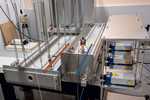|
|
|
|
Recent spectacular results of gravitational waves obtained by the LIGO system, with frequencies in the 100 Hz regime, make corresponding transmitter-receiver laboratory experiments with full control over cause and effect of great importance. Fully characterized dynamic measurements of gravitation in the laboratory have to date been restricted to frequencies in the mHz regime, due to difficulties in assessing non-gravitational crosstalk and the intrinsically weak nature of gravitational forces. Here we introduce two new, fully characterized experiments at three orders of magnitude higher frequencies where a time-harmonic gravitational force field excites the high Q bending resonance of a free-hanging titanium beam at ca. 42 Hz. Two different excitation systems, a parallel bending beam and two rotating beams, produce gravitationally induced motion with velocity amplitudes up to 90 nm/s. The reliable measurement with sub-pm displacement resolution is made possible by a set-up which combines acoustical, mechanical and electrical isolation, a temperature-stable environment, heterodyne laser interferometry and lock-in detection. The interaction is quantitatively modelled based on Newton’s theory. Our initial results agree with the theory to within about two percent. We determined the near-field gravitational energy flow to be up to 2.5E-20 Watt for the parallel beam setup and 4·E-18 Watt for the excitation with rotating beams. We expect our experiment to make significant progress in directions where current experimental evidence for dynamic gravitation is limited.
|
|
Physikalische Gesellschaft Zürich E-Mail: pgz_info at pgz.ch Web: http://www.pgz.ch |
[ HOME
]
[ Kontakt
]
[ Site Map
]
[ Design
]
Zurich local time 29.4.2024 21:13:03 |
Printer Friendly Version |
